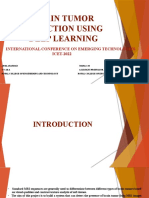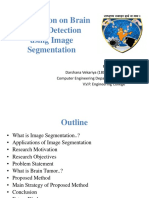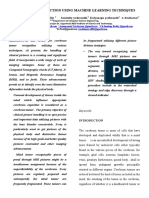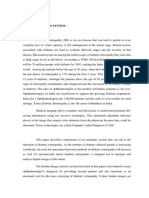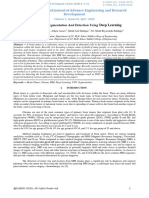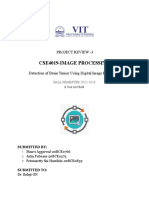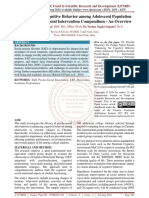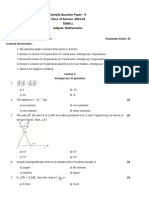Brain Tumor Detection Using MRI Images
Brain Tumor Detection Using MRI Images
Uploaded by
Editor IJTSRDCopyright:
Available Formats
Brain Tumor Detection Using MRI Images
Brain Tumor Detection Using MRI Images
Uploaded by
Editor IJTSRDOriginal Title
Copyright
Available Formats
Share this document
Did you find this document useful?
Is this content inappropriate?
Copyright:
Available Formats
Brain Tumor Detection Using MRI Images
Brain Tumor Detection Using MRI Images
Uploaded by
Editor IJTSRDCopyright:
Available Formats
International Journal of Trend in Scientific Research and Development (IJTSRD)
Special Issue: International Conference on Advances in Engineering, Science and Technology – 2021
Organized by: Uttaranchal Institute of Technology, Uttaranchal University, Dehradun
Available Online: www.ijtsrd.com e-ISSN: 2456 – 6470
Brain Tumor Detection using MRI Images
Deepa Dangwal1, Aditya Nautiyal1, Dakshita Adhikari1, Kapil Joshi2
1B.Tech
Student, 2Assistant Professor,
1,2UIT, Uttaranchal University, Dehradun, Uttarakhand, India
ABSTRACT How to cite this paper: Deepa Dangwal |
Brain tumor segmentation is a very important task in medical image Aditya Nautiyal | Dakshita Adhikari | Kapil
processing. Early diagnosis of brain tumors plays a crucial role in improving Joshi "Brain Tumor Detection using MRI
treatment possibilities and increases the survival rate of the patients. For the Images" Published in International
study of tumor detection and segmentation, MRI Images are very useful in Journal of Trend in Scientific Research
recent years. One of the foremost crucial tasks in any brain tumor detection and Development
system is that the detachment of abnormal tissues from normal brain tissues. (ijtsrd), ISSN: 2456-
Because of MRI Images, we will detect the brain tumor. Detection of unusual 6470, Special Issue |
growth of tissues and blocks of blood within the system is seen in an MRI International
Imaging. Brain tumor detection using MRI images may be a challenging task Conference on
due to the brain's complex structure. Advances in
Engineering, Science IJTSRD42456
In this paper, we propose an image segmentation method to detect tumors
and Technology –
from MRI images using an interface of GUI in MATLAB. The method of
2021, May 2021, pp.1-4, URL:
distinguishing brain tumors through MRI images is often sorted into four
www.ijtsrd.com/papers/ijtsrd42456.pdf
sections of image processing as pre-processing, feature extraction, image
segmentation, and image classification. During this paper, we've used various
Copyright © 2021 by author(s) and
algorithms for the partial fulfillment of the necessities to hit the simplest
International Journal of Trend in Scientific
results that may help us to detect brain tumors within the early stage.
Research and Development Journal. This
KEYWORDS: image processing; deep learning; brain tumor segmentation; MRI is an Open Access article distributed
under the terms of
the Creative
Commons Attribution
License (CC BY 4.0)
(http://creativecommons.org/licenses/by/4.0)
1. INTRODUCTION
Because brain tumors are the most common type of cancer Now that we have a scanned image of the brain, we must
in humans, research into them is crucial. precisely identify the tumor, its size, and its position. The
It is the primary cause of the rise in child and adult death rat Neurosurgeon will need all of this information to complete
es. Headaches, nausea, vomiting, personality and behavioral his diagnosis. This is where CIP (Computerized Image
changes, memory loss, sensory disruption, weakness, and Processing) can assist. We can accurately detect the tumor
numbness is among the signs of brain tumors. using various segmentation approaches and feature
extraction methods.
The term "tumor" refers to abnormal tissue growth. Brain
tumors are divided into two categories: benign and Tumors can damage all healthy brain cells directly, and they
malignant tumors. In the case of a brain tumor, MRI imaging can also harm healthy cells indirectly by crowding other
is crucial for analysis, diagnosis, and therapy planning. When sections of the brain. The proposed approaches are applied
compared to other commonly used X-ray scanners, the to an MRI scan of the human brain, which serves as the
images produced by an MRI scan are better at exhibiting system's input images or original images. At the same time
small details and so have a greater diagnostic quality. as histogram equalization methods are being processed, the
RGB input photos will be converted to grayscale in the pre-
In this paper, we will primarily focus on improving existing
processing stage.
image processing algorithms or designing a better strategy
for tumor diagnosis with a reliable graphical user interface.
@ IJTSRD | Unique Paper ID – IJTSRD42456 | ICAEST-21 | May 2021 Page 1
Special Issue: International Conference on Advances in Engineering, Science and Technology – 2021 (ICAEST-21)
Available online @ www.ijtsrd.com eISSN: 2456-6470
2. Methodology:
Data Preproces Feature
Collection sing extraction
Kaggle Dataset Input Image
Grayscale, Anisotropic
diffusion, Image
enhancement
Benign
Yes Image
Classification Tumor Segmentation
found?
Malignant
No
SVM, ANN, SOM, Threshold segmentation
Fuzzy, PNN, MRF, Watershed segmentation
RF Clustering K-mean
Clustering
2.1. Preprocessing:
The pre-processing stage improves an image by removing converting an RGB image to a grayscale image, only 8 bits are
undesired distortions and showing observable areas of the required to save a single pixel of the image. As a result,
image. The input image is converted to grayscale, which storing a grayscale image will take up 33% less memory than
improves image quality. It's a catch-all term for operations storing an RGB image.
on images at the most basic level of abstraction. To increase
Grayscale images are far more convenient to work within a
the detection of the problematic region from an MRI,
variety of situations, like as It is easier to deal with a single-
preprocessing techniques are applied.
layered image (Grayscale image) than a three-layered image
Before we begin processing our image, we must ensure that in many morphological processes and image segmentation
it is free of extraneous data and in the correct format for problems (RGB color image ) because it is easier to detect
processing in order for the results to be accurate. Pre- features in a grayscale image rather than MRI images
processing is the term used to describe this procedure.
2. Anisotropic diffusion
Conversion to grayscale, noise reduction and noise removal, Anisotropic diffusion reduces visual noise without deleting
picture reconstruction, image augmentation, and, in the case substantial portions of the image information, such as edges,
of medical pictures, steps such as skull removal from an MRI lines, or other crucial elements for visual interpretation.
are all examples of pre-processing.
3. Image enhancement
Converting a picture to grayscale is one of the most used pre- Before processing, image enhancement is the process of
processing techniques. A grayscale image is frequently increasing the quality and information content of raw data.
mistaken for a black and white image, but this is not the case. Contrast enhancement, density slicing, spatial filtering, are
Because a black and white image has only two hues, black all common techniques for image enhancement
and white, the intensity can be either 1 or 0. A grayscale
image, on the other hand, is made up of shades of grey with
no apparent color.
This means that without revealing any color, each pixel
indicates the intensity value at that pixel. A grayscale image,
unlike a black and white image, has a variety of colors, with
white being the lightest and black being the deepest. The
intensity values of a pixel in a grayscale image are also not
absolute and can be infractions.
So basically we are dividing preprocessing stage into 3 main 2.2. Feature extraction:
steps: The most important part of image processing is feature
1. Converting MRI images to grayscale image: extraction. It is done for reducing the original dataset by
We are converting MRI images into grayscale for the measuring and extracting certain features. Feature
following reasons - extraction starts from an initial set of data and builds
An RGB color image requires 8*3 = 24 bits to store a single features that are informative and non-redundant.
color pixel (8 bits for each color component); however, when
@ IJTSRD | Unique Paper ID – IJTSRD42456 | ICAEST-21 | May 2021 Page 2
Special Issue: International Conference on Advances in Engineering, Science and Technology – 2021 (ICAEST-21)
Available online @ www.ijtsrd.com eISSN: 2456-6470
It entails reducing the number of resources required to 2.4. Classification:
accurately describe a huge quantity of data. When The tumor is additionally classified in two: malignant and
performing an analysis of complex data the major problems benign. Benign tumors are non-cancerous cells that do not
stem from a number of variables involved. When input data infiltrate healthy tissue around them. The growth is very
to an algorithm is too large to be processed and data is slow and the periphery or edge of the benign tumor can be
redundant, feature extraction is used. clearly visualized. Benign brain tumors are sometimes life-
threatening when they press the sensitive region of the
While handling images, feature extraction is done, if the
brain. Malignant tumors are cancerous cells, which do invade
feature dimension is high, then feature selection or feature
surrounding healthy tissue and spread to another part of the
transformation is done where high-quality discriminant
brain or spine. This tumor grows very faster and more fatal
features are extracted.
than a benign tumor. In order to treat tumors in the brain, a
In this stage, the input image is transformed into squashed classification technique is used which can easily detect the
form, it extracts features. These features include contrast, type of tumor.
energy, entropy, smoothness, variance, standard deviation,
Based on the existing papers on brain tumor classification,
etc which are useful in the classification stage. The output
various techniques can be used for classification such as
from the feature extraction stage can be used as an input to
SVM, ANN, SOM, Fuzzy, PNN, MRF, RF, and CNN. In this
the classification stage.
paper, the SVM technique is used. The classification method
The existence of tumors can be detected using features. categorizes all pixels in a digital image. SVM is a supervised
These features are analyzed and detection of tumor region is learning method that is used for data analysis and
done. This is how the tumor region is extracted in the MRI classification. It operates based on a decision plane,
Image. When features for tumor and non-tumor MRI images separating things with distinct class properties.
are extracted, they are used to train the different algorithms.
This technique can be used for very large data as well due to
2.3. Image segmentation: its fast learning speed. The classification of brain tumors is
The segmentation is the most important stage for analyzing used to identify the tumor class present in the MRI image. It
images properly since it affects the accuracy of the has two basic steps of training and testing. After this phase,
subsequent steps. Pathologists use hematoxylin and eosin to accurate tumor type is found in the input image. Because of
stain body tissue during cancer diagnosis to distinguish its high generalization, the Support Vector Machine (SVM)
between tissue types. As a result, we apply image approach is considered a good candidate performance,
segmentation to identify the different tissue types in their especially when the feature space's dimension is very large.
images. Converting an image into a collection of pixels
represented by a mask or a labeled image is the process of
image segmentation. By dividing an image into segments, we
can identify the important segments of the image. However,
proper segmentation of images is difficult because of the
great varieties of lesion shapes, sizes, and colors along with
different skin types and textures. In addition to this, some
lesions have irregular boundaries and in some cases, there is
a smooth transition between the lesion and the skin so this Normal Image Benign tumor Malignant tumor
creates problems while doing image processing. To solve
these problems, several techniques have been developed to 3. Conclusion & Future Scope:
overcome this problem. In the medical field, manual identification of brain tumors by
doctors referring to the MRI images is a very time-
They can be broadly classified as thresholding, region-based, consuming task and can be inappropriate for a large amount
supervised, and unsupervised classification techniques:- of data. Instead of manual identification, image processing
Threshold segmentation can be used to identify the tumor from the images.
Therefore, this model helps in understanding the creation of
Watershed segmentation a system that will carry out image processing and identify
Gradient Vector Flow (GVF) the brain tumor MATLAB tools. And also show the location of
the tumor in the highlighted area of the image.
Clustering
In near future, a database can be created for different
K-mean Clustering patients having different types of brain tumors and locate
them. Tumor growth can be analyzed by plotting a graph
which can be obtained by studying sequential images of
tumor effect. A possible extension of the presented work
could use more features. Connecting the system to the
hospital's cloud storage of patient data would be helpful.
This application can be enhanced to provide mobile phone
accessibility and usability.
If this application is developed to analyze all types of MRI
scans of the same patient and the results of all scans are
integrated, it can suggest appropriate treatment and
medication as well.
@ IJTSRD | Unique Paper ID – IJTSRD42456 | ICAEST-21 | May 2021 Page 3
Special Issue: International Conference on Advances in Engineering, Science and Technology – 2021 (ICAEST-21)
Available online @ www.ijtsrd.com eISSN: 2456-6470
4. References Tumor Detection and Feature Extraction Using
[1] Ms. Priya Patil, Ms. Seema Pawar, Ms. Sunayna Patil, Biologically Inspired BWT and SVM”, International
Prof. Arjun Nichal, “ A Review Paper on Brain Tumor Journal of Biomedical Imaging Volume 2017
Segmentation and Detection ”, International Journal of
[11] M. Havaei, A. Davy, D. Warde-Farley, A. Biard, A.
Innovative Research in Electrical, Electronics,
Courville, Y. Bengio, C. Pal, P.-M. Jodoin, and H.
Instrumentation and Control Engineering, Vol. 5,
Larochelle, “Brain tumor segmentation with deep
Issue 1, January 2017.
neural networks,” Medical image analysis, vol. 35, pp.
[2] Luxit Kapoor, Sanjeev Thakur, Professor, 2017 his 18-31, 2017.
paper “A Survey on Brain Tumor Detection Using
[12] H. Dong, G. Yang, F. Liu, Y. Mo, and Y. Guo, “Automatic
Image Processing Techniques", International
Brain Tumor Detection and Segmentation Using U-Net
Conference on Cloud Computing, Data Science &
Based Fully Convolutional Networks,” arXiv preprint
Engineering – Confluence 2017
arXiv: 1705.03820, 2017.
[3] Prabhjot Kaur Chahal1 · Shreelekha Pandey1 · Shivani
[13] Sehgal A, Goel S, Mangipudi P, Mehra A, Tyagi D,”
Goel2, “A survey on brain tumor detection techniques
Automatic brain tumor segmentation and extraction
for MR images”, © Springer Science+Business Media,
in MR images”, Conference on Advances in Signal
LLC, part of Springer Nature 2020, 22 March 2019 /
Processing (CASP) June 2016.
Revised: 11 February 2020 / Accepted: 27 March
2020. [14] Xiao Z, Huang R, Ding Y, Lan T, Dong R, Qin Z,”A deep
learning-based segmentation method for brain tumor
[4] Ali IúÕna, Cem Direko lub, Melike ùahc, “Review of
in MR images”, IEEE 6th International Conference on
MRI-based brain tumor image segmentation using
Computational Advances in Bio and Medical Sciences
deep learning methods”, 12th International
(ICCABS) 2016.
Conference on Application of Fuzzy Systems and Soft
Computing, ICAFS 2016, 29-30 August 2016 [15] Mohsen H, El-Dahshan ESA, El-Horbaty ESM, Salem
ABM,” Classification using deep learning neural
[5] J. Amin, M. Sharif, M. Yasmin, S.L. Fernandes,” Big data
networks for brain tumors”, Future Compututing and
analysis for brain tumor detection: Deep
information journal 3(2018).
convolutional neural networks”, Future Generation
Computer Systems (2018) [16] Joshi, K., Gupta, H., Chaudhary, P., & Sharma, P. Survey
on different Enhanced k-means Clustering Algorithm.
[6] Mahmoud Khaled Abd-Ellaha, Ali Ismail Awadb,c,,
International Journal of Engineering Trends and
Ashraf A.M. Khalafd, Hesham F.A. Hamedd,” A review
Technology (IJETT)–Volume, 27.
on brain tumor diagnosis from MRI images: Practical
implications, key achievements, and lessons learned”, [17] Chauhan, N., Dhaundiyal, R., & Joshi, K. K-MEANS ON
Magnetic Resonance Imaging 61(2019) SEARCH ENGINE DATASET THROUGH WEKA.
International Journal of Research Fellow for
[7] Sethuram Rao.G, Vydeki.D, “Brain Tumor Detection
Engineering (IJRFE)–Volume, 4.
Approaches: A Review”, International Conference on
Smart Systems and Inventive Technology (ICSSIT [18] Joshi, K., Rawat, S., & Chaudhary, S. ANALYSIS OF
2018) DIFFERENT OPTICAL SWITCHING TECHNIQUES IN
NOC ROUTER ARCHITECTURE. International Journal
[8] Kanmani, M. and Dr. Pushparani, M.,” . “Brain tumor
of Research Fellow for Engineering (IJRFE)–Volume, 4.
detection and classification”, International Journal of
Current Research, 8, (05), 31634-31637.0 [19] Joshi, K., Chaudhary, S., & Chauhan, N. HYBRID
CLUSTERING ALGORITHM USING K-MEANS
[9] Swapnil R. Telrandhe, Amit Pimpalkar, Ankita
CLUSTERING ALGORITHM. International Journal of
Kendhe,” Detection of Brain Tumor from MRI images
Research Fellow for Engineering (IJRFE)–Volume, 4.
by using Segmentation &SVM”, 2016 World
Conference on Futuristic Trends in Research and [20] Longkumer, M., Joshi, K. A Comprehensive Study on
Innovation for Social Welfare (WCFTR’16) Recent Botnet. International Journal of Science and
Research (IJSR)- Volume, 7.
[10] Nilesh Bhaskarrao Bahadure, Arun Kumar Ray,and
Har Pal Thethi,” Image Analysis for MRI Based Brain
@ IJTSRD | Unique Paper ID – IJTSRD42456 | ICAEST-21 | May 2021 Page 4
You might also like
- Platinum Mathematics Grade 4 Lesson PlansDocument56 pagesPlatinum Mathematics Grade 4 Lesson PlansMpho Sekotlong76% (70)
- TP3 2022 Exercises For CES Edupack Required QuestionsDocument28 pagesTP3 2022 Exercises For CES Edupack Required QuestionsSenanga KeppitipolaNo ratings yet
- Breast Cancer Prediction Using Machine LearningDocument8 pagesBreast Cancer Prediction Using Machine LearninghaiminalNo ratings yet
- Mini Project Final ReviewDocument34 pagesMini Project Final ReviewArya Anandan100% (1)
- Presentation On Brain Tumor DetectionDocument23 pagesPresentation On Brain Tumor DetectionVekariya DarshanaNo ratings yet
- Estimation of Age and Gender Using Convolutional Neural NetworkDocument35 pagesEstimation of Age and Gender Using Convolutional Neural NetworkNagesh Singh Chauhan100% (1)
- Implementation of A 16-Bit RISC Processor Using FPGA ProgrammingDocument25 pagesImplementation of A 16-Bit RISC Processor Using FPGA ProgrammingTejashree100% (3)
- Brain Tumor ReportDocument45 pagesBrain Tumor ReportakshataNo ratings yet
- Brain Tumour Detection Using The Deep LearningDocument8 pagesBrain Tumour Detection Using The Deep LearningIJRASETPublicationsNo ratings yet
- Brain Tumor Detection Using Segmentation of MriDocument4 pagesBrain Tumor Detection Using Segmentation of MriInternational Journal Of Emerging Technology and Computer Science100% (1)
- Brain Tumor Detection AbstractDocument8 pagesBrain Tumor Detection AbstractSruthi SomanNo ratings yet
- Brain Tumor Detection Algorithm PDFDocument5 pagesBrain Tumor Detection Algorithm PDFGanapathy Subramanian.S eee2017No ratings yet
- Report On Brain Tumour Detection ( Major)Document77 pagesReport On Brain Tumour Detection ( Major)Himani Thakkar100% (1)
- Brain Tumor Detection Using Deep LearningDocument9 pagesBrain Tumor Detection Using Deep LearningIJRASETPublicationsNo ratings yet
- Brain Tumor DetectionDocument16 pagesBrain Tumor DetectionBHARATH BELIDE0% (1)
- Brain Tumor Detection Using Machine Learning TechniquesDocument7 pagesBrain Tumor Detection Using Machine Learning TechniquesYashvanthi SanisettyNo ratings yet
- Image Processing Techniques For Brain Tumor Detection: A ReviewDocument5 pagesImage Processing Techniques For Brain Tumor Detection: A ReviewInternational Journal of Application or Innovation in Engineering & ManagementNo ratings yet
- Brain Tumor Detection Using CNNDocument10 pagesBrain Tumor Detection Using CNNIJRASETPublicationsNo ratings yet
- Brain Tumor Classification Using Deep Learning AlgorithmsDocument12 pagesBrain Tumor Classification Using Deep Learning AlgorithmsIJRASETPublicationsNo ratings yet
- Tumor DetectionDocument97 pagesTumor DetectionParthi Ban100% (1)
- 1.1 Introduction To SystemDocument19 pages1.1 Introduction To SystemRavi KumarNo ratings yet
- Brain Tumor Detection Using Machine LearningDocument9 pagesBrain Tumor Detection Using Machine LearningRayban PolarNo ratings yet
- Brain Tumor MLDocument13 pagesBrain Tumor MLSHREEKANTH B KNo ratings yet
- Tumor Detection Through Mri Brain Images: Rohit Arya 20MCS1009Document25 pagesTumor Detection Through Mri Brain Images: Rohit Arya 20MCS1009Rohit AryaNo ratings yet
- Face Recognition Using Neural Network: Seminar ReportDocument33 pagesFace Recognition Using Neural Network: Seminar Reportnikhil_mathur10100% (3)
- Final PPTDocument39 pagesFinal PPTNitesh KumarNo ratings yet
- Brain Tumour Analysis Using Image ProcesssingDocument48 pagesBrain Tumour Analysis Using Image ProcesssingSwathi GudlaNo ratings yet
- Pneumonia Detection Using VGG19 (Group No. 10)Document20 pagesPneumonia Detection Using VGG19 (Group No. 10)Amrit Kumar100% (1)
- Age and Gender Classification Using CNN CVPR2015Document9 pagesAge and Gender Classification Using CNN CVPR2015pinkymoonNo ratings yet
- Dermatological Disorder Detection Using Machine LearningDocument4 pagesDermatological Disorder Detection Using Machine LearningInternational Journal of Innovative Science and Research TechnologyNo ratings yet
- Brain Tumor Final Report LatexDocument29 pagesBrain Tumor Final Report LatexMax WatsonNo ratings yet
- Breast Cancer Detection With Machine LearningDocument7 pagesBreast Cancer Detection With Machine LearningIJRASETPublicationsNo ratings yet
- Recent Research Papers On Medical Image Processing PDFDocument5 pagesRecent Research Papers On Medical Image Processing PDFiiaxjkwgfNo ratings yet
- Batch 8 Kidney Stone - Updated - PPTDocument32 pagesBatch 8 Kidney Stone - Updated - PPTAnjali Krishna singhNo ratings yet
- Skin Cancer Detection Using Convolutional Neural Network: Guide Name: Mrs. K .VeenaDocument15 pagesSkin Cancer Detection Using Convolutional Neural Network: Guide Name: Mrs. K .VeenaJaywanth Singh RathoreNo ratings yet
- Brain Tumor Segmentation and Detection Using Deep LearningDocument5 pagesBrain Tumor Segmentation and Detection Using Deep Learningmohammad arshad siddiqueNo ratings yet
- First Review PDFDocument36 pagesFirst Review PDFPallavi SaxenaNo ratings yet
- Age and Gender DetectionDocument13 pagesAge and Gender DetectionAnurupa bhartiNo ratings yet
- COVID-19 Image Classification Using Deep learning-ScienceDirectDocument34 pagesCOVID-19 Image Classification Using Deep learning-ScienceDirectGaspar PonceNo ratings yet
- Report On Brain Tumor - Docx1Document35 pagesReport On Brain Tumor - Docx1Monika DebnathNo ratings yet
- Pneumonia Detection: Department of CSE, NITDocument17 pagesPneumonia Detection: Department of CSE, NITAkashNo ratings yet
- Detection of Covid-19 Using Deep LearningDocument6 pagesDetection of Covid-19 Using Deep LearningIJRASETPublicationsNo ratings yet
- Breast Cancer Classification Using Machine LearningDocument9 pagesBreast Cancer Classification Using Machine LearningVinothNo ratings yet
- Lung Disease Prediction From X Ray ImagesDocument63 pagesLung Disease Prediction From X Ray ImagesAyyavu M100% (1)
- Identification of Presence of Brain Tumors in MRI Images Using Contrast Enhancement TechniqueDocument8 pagesIdentification of Presence of Brain Tumors in MRI Images Using Contrast Enhancement Techniqueraymar2kNo ratings yet
- Chapter - 1Document16 pagesChapter - 1Waseem MaroofiNo ratings yet
- Brain Gate Technology (Seminar)Document16 pagesBrain Gate Technology (Seminar)SrūJãn Chinnabathini100% (1)
- Age and Gender Using OPENCVDocument49 pagesAge and Gender Using OPENCVShapnaNo ratings yet
- Imageprocessing FinaldocDocument60 pagesImageprocessing FinaldocPattu SCNo ratings yet
- Blue Eyes Technology (ABSTRACT)Document19 pagesBlue Eyes Technology (ABSTRACT)Abha Singh90% (30)
- Iris Recognition Project DocumentDocument61 pagesIris Recognition Project DocumentRevathi33% (3)
- Convolutional Neural NetworkDocument3 pagesConvolutional Neural NetworkMahimaKadyanNo ratings yet
- Diabetic Retinopathy DetectionDocument6 pagesDiabetic Retinopathy DetectionThamimul AnsariNo ratings yet
- Graphical Password Authentication - YaminiDocument19 pagesGraphical Password Authentication - Yaminibonkuri yaminiNo ratings yet
- Fruit OldDocument37 pagesFruit OldAswin KrishnanNo ratings yet
- BG3801 L3 Medical Image Processing 14-15Document18 pagesBG3801 L3 Medical Image Processing 14-15feiboiNo ratings yet
- Brain Tumor Detection Using Deep Learning: Birla Vishvakarma Mahavidyalaya Vallabh Vidyanagar - 388120 Gujarat, IndiaDocument40 pagesBrain Tumor Detection Using Deep Learning: Birla Vishvakarma Mahavidyalaya Vallabh Vidyanagar - 388120 Gujarat, Indiahamed razaNo ratings yet
- Research Methodology3Document10 pagesResearch Methodology3mehakk.lunkarNo ratings yet
- BTD Survey Paper Draft 1Document7 pagesBTD Survey Paper Draft 1Manas pandeyNo ratings yet
- Goyal 2021 IOP Conf. Ser. Mater. Sci. Eng. 1022 012011Document10 pagesGoyal 2021 IOP Conf. Ser. Mater. Sci. Eng. 1022 012011Abhishek R BhatNo ratings yet
- 1 s2.0 S1746809421000744 MainDocument14 pages1 s2.0 S1746809421000744 Mainمظفر حسنNo ratings yet
- An Approach To Detect The Presence of Neoplasm With Convolutional Neural NetworkDocument4 pagesAn Approach To Detect The Presence of Neoplasm With Convolutional Neural NetworkInternational Journal of Innovative Science and Research TechnologyNo ratings yet
- IET Image Processing - 2023 - Dheepak - MEHW SVM Multi Kernel Approach For Improved Brain Tumour ClassificationDocument19 pagesIET Image Processing - 2023 - Dheepak - MEHW SVM Multi Kernel Approach For Improved Brain Tumour Classificationgagan2812No ratings yet
- Case of Benign Prostatic Hyperplasia by Homoeopathy A Case ReportDocument4 pagesCase of Benign Prostatic Hyperplasia by Homoeopathy A Case ReportEditor IJTSRDNo ratings yet
- Green Victimolgy An IntroductionDocument8 pagesGreen Victimolgy An IntroductionEditor IJTSRDNo ratings yet
- Joyful Collaborative Teaching For Junior High School Araling Panlipunan 10Document18 pagesJoyful Collaborative Teaching For Junior High School Araling Panlipunan 10Editor IJTSRDNo ratings yet
- The Burden of Care A Systematic Review of Parental Stress in Families of Children With Intellectual DisabilitiesDocument8 pagesThe Burden of Care A Systematic Review of Parental Stress in Families of Children With Intellectual DisabilitiesEditor IJTSRDNo ratings yet
- Barriers Faced by People With Visual Impairment in Securing Employment in The City of Manzini, EswatiniDocument10 pagesBarriers Faced by People With Visual Impairment in Securing Employment in The City of Manzini, EswatiniEditor IJTSRDNo ratings yet
- A Study On Educational Discrimination in The Chinese WorkplaceDocument5 pagesA Study On Educational Discrimination in The Chinese WorkplaceEditor IJTSRDNo ratings yet
- An Assessment of The Applications of Artificial Intelligence AI in Remote Sensing and Geographical Information System GISDocument7 pagesAn Assessment of The Applications of Artificial Intelligence AI in Remote Sensing and Geographical Information System GISEditor IJTSRDNo ratings yet
- Significance of Sthanika Chikitsa in Kaphaja Yonivyapath A Review ArticleDocument5 pagesSignificance of Sthanika Chikitsa in Kaphaja Yonivyapath A Review ArticleEditor IJTSRDNo ratings yet
- Instructional Humor and Its Compliance Gained During Virtual LearningDocument35 pagesInstructional Humor and Its Compliance Gained During Virtual LearningEditor IJTSRDNo ratings yet
- Utilization of Copper Slag and Hypo Sludge As Alternative Material in ConcreteDocument4 pagesUtilization of Copper Slag and Hypo Sludge As Alternative Material in ConcreteEditor IJTSRDNo ratings yet
- The Impact of Domestic Abuse On Children Prenatal To 5 Years Implications For Social Work PracticeDocument10 pagesThe Impact of Domestic Abuse On Children Prenatal To 5 Years Implications For Social Work PracticeEditor IJTSRDNo ratings yet
- Assessing The Impact of Information Communication Technology ICT in The Teaching and Learning of Social Studies in Senior High Schools in Ghana A Case of Eastern Region SchoolsDocument25 pagesAssessing The Impact of Information Communication Technology ICT in The Teaching and Learning of Social Studies in Senior High Schools in Ghana A Case of Eastern Region SchoolsEditor IJTSRDNo ratings yet
- Moral Ramifications and DifficultiesDocument7 pagesMoral Ramifications and DifficultiesEditor IJTSRDNo ratings yet
- Assessment of The Nigerian Television Authority NTA, Abuja, Signal Strength With Atmospheric ComponentsDocument6 pagesAssessment of The Nigerian Television Authority NTA, Abuja, Signal Strength With Atmospheric ComponentsEditor IJTSRDNo ratings yet
- Exploring The Ethnomedicinal Potential of Black Turmeric Curcuma Caesia Roxb. A Comprehensive ReviewDocument6 pagesExploring The Ethnomedicinal Potential of Black Turmeric Curcuma Caesia Roxb. A Comprehensive ReviewEditor IJTSRDNo ratings yet
- Role of Language Teacher in SocietyDocument3 pagesRole of Language Teacher in SocietyEditor IJTSRDNo ratings yet
- Enhancing The Cognitive Behavior Among Adolescent Population Through Psycho Social Intervention Compendium An OverviewDocument3 pagesEnhancing The Cognitive Behavior Among Adolescent Population Through Psycho Social Intervention Compendium An OverviewEditor IJTSRDNo ratings yet
- Learning Management Systems and Self Directed Learning in Higher Education Institutions in CameroonDocument26 pagesLearning Management Systems and Self Directed Learning in Higher Education Institutions in CameroonEditor IJTSRDNo ratings yet
- The Use of Storytelling As A Teaching Strategy in Primary School Literacy InstructionDocument5 pagesThe Use of Storytelling As A Teaching Strategy in Primary School Literacy InstructionEditor IJTSRDNo ratings yet
- Factors Affecting Individuals To Adopt Green Banking Empirical Evidence From The UTAUT ModelDocument9 pagesFactors Affecting Individuals To Adopt Green Banking Empirical Evidence From The UTAUT ModelEditor IJTSRDNo ratings yet
- Role of Libraries in The Context of Research and Educational InstitutionsDocument3 pagesRole of Libraries in The Context of Research and Educational InstitutionsEditor IJTSRDNo ratings yet
- Comparative Effects of Lime and Banana Leaf Ash On Engineering Property of SoilDocument4 pagesComparative Effects of Lime and Banana Leaf Ash On Engineering Property of SoilEditor IJTSRDNo ratings yet
- Comparative Analysis of Plaque Retention Between Conventional Brackets and Self Ligating Brackets Using Plaque IndexDocument4 pagesComparative Analysis of Plaque Retention Between Conventional Brackets and Self Ligating Brackets Using Plaque IndexEditor IJTSRDNo ratings yet
- Emerging Trends On OER'Document3 pagesEmerging Trends On OER'Editor IJTSRDNo ratings yet
- Student Centered Teaching Design and Practical Effect Analysis of Big Data Computing and Storage CourseDocument7 pagesStudent Centered Teaching Design and Practical Effect Analysis of Big Data Computing and Storage CourseEditor IJTSRDNo ratings yet
- Global Burden of Disease GBD An IntroductionDocument8 pagesGlobal Burden of Disease GBD An IntroductionEditor IJTSRDNo ratings yet
- Comparing Development of Human Right Values in Secondary School Teachers With Relation To Locality and Gender of Aurangabad DistrictDocument6 pagesComparing Development of Human Right Values in Secondary School Teachers With Relation To Locality and Gender of Aurangabad DistrictEditor IJTSRDNo ratings yet
- Practical Attempts at Building Smart Courts With The Assistance of Generative Artificial IntelligenceDocument5 pagesPractical Attempts at Building Smart Courts With The Assistance of Generative Artificial IntelligenceEditor IJTSRDNo ratings yet
- Review Article On VranaDocument8 pagesReview Article On VranaEditor IJTSRDNo ratings yet
- Enhancing The Properties of Expansive Soil Stabilized With Sisal Fibre and Fly AshDocument7 pagesEnhancing The Properties of Expansive Soil Stabilized With Sisal Fibre and Fly AshEditor IJTSRDNo ratings yet
- BS Course OutlineDocument20 pagesBS Course OutlineHadia Azhar2558No ratings yet
- 01-Diesel Engine Basics (R1.2jb)Document29 pages01-Diesel Engine Basics (R1.2jb)donsallus100% (1)
- Backup AND Restore / Update Firmware: Doug WendykerDocument12 pagesBackup AND Restore / Update Firmware: Doug WendykerJahaziel Rubio GerardoNo ratings yet
- 582 Emerge Theory PDFDocument25 pages582 Emerge Theory PDFKurniasari FitriaNo ratings yet
- Cortex Diagnose ReportDocument18 pagesCortex Diagnose ReportRamesh NathanNo ratings yet
- Control Valves: By: Nony Maulidya (161440030) Wahyu Ainur Agustin (161440040)Document80 pagesControl Valves: By: Nony Maulidya (161440030) Wahyu Ainur Agustin (161440040)ryan zainNo ratings yet
- Chapter 5 - Adding CapacityDocument4 pagesChapter 5 - Adding CapacityChinh Dao QuangNo ratings yet
- Kung Et Al. (2018)Document14 pagesKung Et Al. (2018)Henry Daniel Ruiz AlbaNo ratings yet
- Norsok M-601 (Welding and Inspecrtion of Piping)Document24 pagesNorsok M-601 (Welding and Inspecrtion of Piping)John PaulNo ratings yet
- Problems of Education in The 21st Century, Vol. 80, No. 6, 2022Document129 pagesProblems of Education in The 21st Century, Vol. 80, No. 6, 2022Scientia Socialis, Ltd.No ratings yet
- Top DBA Shell Scripts For Monitoring The DatabaseDocument9 pagesTop DBA Shell Scripts For Monitoring The DatabaseIan HughesNo ratings yet
- Insulation 4 Less, The Official Prodex SiteDocument2 pagesInsulation 4 Less, The Official Prodex SiteInsulation ForLessNo ratings yet
- Convert Drive Test Log To Google Earth Thematic MapDocument7 pagesConvert Drive Test Log To Google Earth Thematic MapiqbalcanNo ratings yet
- Wind Farm EarthingDocument3 pagesWind Farm EarthinggioutsosNo ratings yet
- Hugon Dharmakirti ApohaDocument25 pagesHugon Dharmakirti ApohademczogNo ratings yet
- Armstrong Bollhoff HeliCoilDocument28 pagesArmstrong Bollhoff HeliCoilThor InternationalNo ratings yet
- A Electrical PDFDocument163 pagesA Electrical PDFsyed yaqubNo ratings yet
- The Influence of Job Stress On JobDocument6 pagesThe Influence of Job Stress On JobInternational Journal of Innovative Science and Research TechnologyNo ratings yet
- Nonlinear Deformation Analyses of An Embankment Da 2016 Soil Dynamics and EaDocument12 pagesNonlinear Deformation Analyses of An Embankment Da 2016 Soil Dynamics and EaaditNo ratings yet
- 8PQ9800 1aa55Document9 pages8PQ9800 1aa55Kevin ChacónNo ratings yet
- Practice Excel 2Document3 pagesPractice Excel 2Ashish P SharmaNo ratings yet
- Sample Question Paper - 4 Class-IX Session - 2021-22Document16 pagesSample Question Paper - 4 Class-IX Session - 2021-22Sahana. S 21752No ratings yet
- High Speed Super Low Power SRAM: CS16LV81923Document19 pagesHigh Speed Super Low Power SRAM: CS16LV81923Manutenção eletrônicaNo ratings yet
- CAE CAD ManipulationDocument81 pagesCAE CAD Manipulationmanuanil1989No ratings yet
- Diamond & Related Materials: SciencedirectDocument6 pagesDiamond & Related Materials: SciencedirectmedixbtcNo ratings yet
- XII Maths Preboard 2020-21 SP-4Document13 pagesXII Maths Preboard 2020-21 SP-4Ansh JainNo ratings yet
- 1.what Is A Data Structure? What Are The Types of Data Structures?Document13 pages1.what Is A Data Structure? What Are The Types of Data Structures?ali_afzal89No ratings yet



